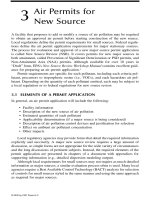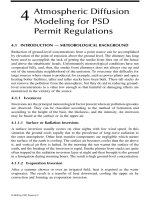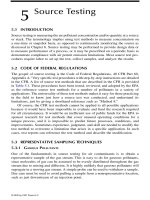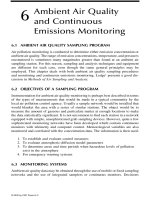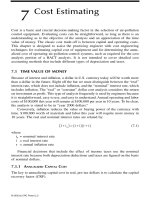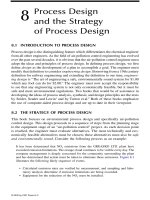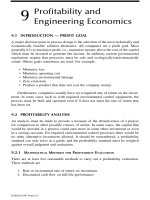AIR POLLUTION CONTROL EQUIPMENT SELECTION GUIDE - CHAPTER 20 (end) ppsx
Bạn đang xem bản rút gọn của tài liệu. Xem và tải ngay bản đầy đủ của tài liệu tại đây (4.55 MB, 22 trang )
© 2002 by CRC Press LLC
chapter 20
Wet electrostatic
precipitators*
Device type
The wet electrostatic precipitator (WESP) is a mechanical device that uses
primarily electrostatic forces to separate particulate from gas streams. The
collecting surfaces are periodically cleaned using water or other suitable
conductive flushing liquid; thus, the name wet electrostatic precipitator.
The basic components of a WESP are shown in Figure 20.1. They consist
of either a low level (shown) or high level gas inlet, collecting tubes, mast
type electrodes mounted on a grid or frame, a high voltage insulator section,
an air-purged insulator compartment to prevent particulate from coating the
high voltage insulator section, a high voltage power supply (trans-
former/rectifier set), and a gas outlet.
The designs also include various types of cleaning or irrigation systems
that are used to purge the tubes of captured particulate. These purge systems
may include fog nozzles, spray nozzles, or weir type irrigation systems.
Typical applications and uses
WESPs are frequently used to collect submicron particulate that arises from
combustion, drying operations, process chemical production, and similar
sources. They are also used as polishing devices to reduce particulate load-
ings to extremely low levels. They are generally used where the inlet loading
of particulate is under 0.5 grs/dscf and where corrosive gases may be
present. They also excel where the particulate is sticky but can be water
flushed. They often replace fiberbed filters or similar coalescing devices
where solid particulate is present that could plug the fiberbed design.
Wet precipitators are increasingly being used as final cleanup devices
behind and in combination with other air pollution control devices.
* This chapter is contributed by Wayne T. Hartshorn, Hart Environmental, Inc., Lehighton,
Pennsylvania.
© 2002 by CRC Press LLC
Applications include chemical and hazardous waste incinerators; hog fuel
boilers; acid mists; steel mill applications; vapor-condensed organics;
nonferrous metal oxide fumes from calciners, roasters, and reverb fur-
naces; phosphate rock; veneer dryers; sludge incinerators; and blue haze
and fume control. Figure 20.2 shows a WESP on a popular application,
a veneer dryer.
The wet electrostatic precipitator can provide, in addition to fine or
submicron particulate control, a final cleanup of mist elimination.
Another common application is on particle board dryers. These emis-
sions can contain a combination of large particulate fines plus condensable
aerosols. These products tend to be sticky so the WESP, properly designed,
is a good candidate for its control. On this unit, the WESP is in the center
of the picture and a droplet eliminator and fan is to the left of center. The
gas flow is downward, thereby flushing solids toward the sump, assisted by
gravity. The bypass stack for the dryer can be seen in the background.
Primary mechanisms used
Electrostatic forces as well as diffusional forces are used to accomplish the
separation. On some designs wherein the collecting tubes or surfaces are air
or liquid cooled, thermophoretic forces are also used. In general, a series of
zones are created wherein electrostatic forces sweep the particulate from the
gas stream toward the contact (collecting) surface, which is periodically
flushed with water to prevent the buildup of a resistive layer.
Figure 20.1
WESP components (Entoleter, Inc.).
CLEAN GAS OUT
PURGED
INSULATOR
COMPARTMENT
DIRTY GAS IN
COLLECTING
TUBE
HIGH VOLTAGE
INSULATOR
ELECTRODE
SUPPORT BEAM
© 2002 by CRC Press LLC
To a minor extent, the WESP is also a gas absorber. The flushing system
can also provide some mass transfer of contaminant gases into the liquid.
Design basics
WESPs consist of emitting electrodes mounted inside collecting tubes. A high
voltage is introduced to the emitting electrode and a corona (charged field)
is produced between the emitting electrode and the collecting electrode.
Pollutant particles (sometimes solids, sometimes aerosols, often a mixture
Figure 20.2
WESP on veneer dryer (Geoenergy International, Corp.).
Figure 20.3
Particle board dryer WESP (Geoenergy International, Corp.).
© 2002 by CRC Press LLC
of both) pass through this corona and are moved toward the collecting
electrode where they momentarily attach. Periodically, a flush of liquid (usu-
ally water) flushes the particulate away.
Many manufacturers have extended and extrapolated methods of sizing
electrostatic precipitators. However, there has not been significant change in
the state-of-the-art of electrostatic precipitation. Concentration has been cen-
tered about hardware improvements for reliability (Figure 20.4
)
, voltage, and
spark controls to maintain maximum stable electrical fields (Figure 20
.
5
)
,
increasing sizes to secure compliance with new and more stringent regula-
tions (Figure 20.6
)
, and attention to new and improved materials of construc-
tion for longer life and more resistance to corrosive gases (Figure 20.7
)
.
Further development work has resulted in more effective arrangements and
configurations of collection and charging zones in the devices (Figure 20.8
)
.
Some of this work has provided for higher particle charging or more intense
Figure 20.4
Electrode support of WESP (Hart Environmental, Inc.).
Figure 20.5
Modern WESP high voltage controls (Hart Environmental, Inc. Installa-
tion/NWL Control Corp.).
© 2002 by CRC Press LLC
Figure 20.6
Picture of sonic development
WESP designed and serviced by Wayne T.
Hartshorn.
Figure 20.7
All alloy
WESP electrode bank
(Hart Environmental,
Inc.).
Figure 20.8
Multiple discs on elec-
trode (Hart Environmental, Inc.).
© 2002 by CRC Press LLC
ionization (Figure 20.9
)
. This has definitely added improvements to the state-
of-the-art of fine particle collection.
Notice the insulators on either side of the discharge electrode mast
(center), which passes through to the electrode frame located below.
To control the WESP and reduce sparking, modern solid state controls
are used that incorporate feedback type logic. They bring the voltage up to
the sparking potential then back off slightly, automatically, although the
conditions in the WESP may vary.
The vertical tubular arrangement of the collecting tubes is shown in
Figure 20.6. These tubes may be round or multisided, depending on the
vendor.
To keep the discharge electrode masts centered, some firms use frames
top and bottom. Modern designs use specially designed swivels that allow
alignment of the electrodes, then lock them in place. These swivels are shown
in Figure 20.7 just below the cross members. Because a WESP often handles
corrosive gases, the vessel can be made from corrosion resistant alloys or
even nonmetallic fiberglass (if the surface is suitably prepared with a con-
ducting surface).
To produce high efficiency, some vendors use multiple emitting discs on
the discharge electrodes. These discs are shown in Figure 20.8 as they extend
down into the collecting tube.
Discs are used instead of wire so that a series of intense corona fields
can be produced. This can best be seen diagrammatically in Figure 20.9.
Figure 20.9
Disc vs. wire corona formation comparison (TurboSonic Technologies Inc.).
Disc-In-Tube
Wire-In-Plate
TUBE
DISC
DISC
WEAK FIELD
WEAK
FIELD
SAME
FIELD
TUBE
STRONG FIELD
STRONG FIELD
RADIAL EXPANSION
RADIAL EXPANSION
AXIAL EXPANSION
NO AXIAL EXPANSION
PLATE
PLATE
WIRE
WIRE
© 2002 by CRC Press LLC
The use of modern sparking controls has allowed the use of multiple discs
and therefore multiple corona zones to be produced. A strong corona field
can be produced between the edge of the disc and the collecting tube,
much like the electrode to ground on an automotive spark plug. The
controls of the WESP, however, allow a corona to be formed before the
spark jumps the gap. This combination produces the greatest particulate
control efficiency.
There are two types of electrostatic precipitator technologies. There is
the dry electrostatic precipitator, which is cleaned of collected material by
means of rapping and/or vibrating mechanisms. The wet precipitator is
cleaned of collected material by means of irrigated collecting surfaces
(Figure 20.10
)
.
Until recently, the wet precipitators comprised a small share of the mar-
ket for electrostatic precipitators. Originally, the leading application for wet
precipitators was the collection of sulfuric acid. A typical unit was self-
irrigating, tube-type, and lead-lined fabrication. Reinforced thermosetting
plastic has gained increased acceptance as well.
Figure 20.10
Basic components of a WESP (TurboSonic Technologies Inc.).
INTERMITTENT
FLUSHING HEADER
HIGH VOLTAGE
GRID
HIGH VOLTAGE
CONNECTION
HIGH VOLTAGE
INSULATOR
COMPARTMENT
DRAIN
DISCHARGE DRAIN
COLLECTING
ELECTRODE TUBE
PRECIPITATING
ELECTRODE
DISCHARGE
ELECTRODE
RIGID MAST
ALIGNMENT
MECHANISM
PURGE AIR
CONNECTION
GAS DISTRIBUTION
DEVICES
HIGH VOLTAGE
SUPPORT
INSULATOR
© 2002 by CRC Press LLC
Types of wet precipitators
The design of wet electrostatic precipitators can be characterized by config-
uration, arrangement, irrigating method, and materials of construction.
Configuration
There are two basic precipitator configurations: plate and tube. The plate
type consists of parallel plates with discharge elements assembled between
each plate. The tube type consists of an array of tubes, round or multisided,
with a discharge electrode located in the center of each.
Arrangement
Gas flow can be arranged in parallel or series, and horizontally or vertically.
This feature also distinguishes a wet from a dry precipitator — because
particles are removed from the latter through rapping, it is always arranged
horizontally.
Irrigation method
This has a greater impact on the operation of a wet precipitator than any
other factor. There are many irrigation methods.
In self-irrigation, the most common method, captured liquid droplets
wet the collecting surface. This method only works when the particles are
mostly liquid. In a specialized variation, condensation from the gas stream
wets the collecting surfaces. A cold fluid, usually air, is circulated on the
outside of the collecting tube to promote condensation. As with mist collec-
tors, irrigation by condensation works best with a gas stream high in mois-
ture content and low in particle concentration. For this reason and others,
the WESP is often used as a very high efficiency mist eliminator after other
gas cleaning devices such as fluidized bed and Venturi scrubbers. As shown
in Figure 20.11, it can also be used after gas absorber/coolers such as packed
towers wherein gases are cooled then sub-cooled to condense water vapor
onto water droplets (flux force condensation).
In spray irrigation, spray nozzles continuously irrigate the collecting
surfaces. The spray droplets and the particles form the irrigating film. In
intermittently flushed irrigation, the precipitator operates cyclically. During
collection, it operates as a dry precipitator without rapping. It is periodically
flushed by overhead spray nozzles. This method only works well if the
particles are easily removed.
In film irrigation, a continuous liquid film flushes the collecting sur-
face. Because the film also acts as the collecting surface, the plate or tube
does nothing more than support the film. Therefore, the electrical conduc-
tivity of the irrigating fluid becomes an important factor. Nonconductive
irrigants will not work. Also important are the physical properties of the
© 2002 by CRC Press LLC
film and the liquid-distribution network. The film must be smooth and
well distributed to avoid high voltage arcing, which can damage the unit
and result in poor performance. Additionally, the distribution piping,
plenums and weirs must be designed to avoid dead zones that promote
settling or plugging.
Electrostatic precipitation is made possible by the corona discharge.
Through an effect known as the avalanche process, the corona discharge
provides a simple and stable means of generating the ions to electrically
charge and collect suspended particles or mists. In the avalanche process,
gases in the vicinity of a negatively charged surface break down to form
a plasma, or glow, region when the imposed voltage reaches a critical level
(Figure 20.12
)
. Free electrons in this region are then repulsed toward the
positive, or grounded, surface, and finally collide with gas molecules to
form negative ions.
These ions, being of lower mobility, form a space-charge cloud of the
same polarity as the emitting surface. By restricting further emission of high-
speed electrons, the space charge tends to stabilize the corona. With a corona
established, dust particles or mists in the area become charged by the ions
present, and are driven to the positive electrode by the electric field. Of
Figure 20.11
Flux force condensation type system with WESP (TurboSonic Technol-
ogies Inc.).
INLET
OCS
CONDENSER/ABSORBER
TRANSFORMER/RECTIFIER
I.D. FAN
EXHAUST
STACK
WET-ESP
RECYCLE
DUCT
PACKED
TOWER
© 2002 by CRC Press LLC
course, for the forgoing to be successful, the proper electrode geometry, gas
composition, and voltage must be present.
Particle charging is only the first step in the precipitation process. Once
charged, the particles must be collected. As explained, this happens as a
matter of course because the same forces that cause a particle to acquire a
charge also drive the like-polarity particle to the grounded surface.
The next step is particle removal. In a wet precipitator the material is
rinsed from the collecting surface with an irrigating liquid.
Selecting a wet electrostatic precipitator
The Deutsch equation describes precipitator efficiency under conditions of
turbulent flow:
E
= 1 – exp(–
AW
/
Q
)
where
E
= collection efficiency, 1-(outlet particle concentration/inlet
particle concentration)
A
= area of the collecting surface
W
= velocity of particle migration to the collecting surface
Q
= upward gas flow rate (gas velocity
×
cross-sectional area of
the passage)
The derivation of equation depends on simplifying assumptions, the
most important being: all particles are the same size, the gas velocity profile
is uniform, a captured particle stays captured, the electric field is uniform,
and no zones are untreated.
Figure 20.12
Electrostatic basics (Wayne T. Hartshorn).
Plasma region
Free electrons
Ions
Charged particles
Collected dust
Collecting
electrode
Dust to removal
Gas flow
Discharge electrode
High-voltage
D.C. source
© 2002 by CRC Press LLC
To account for the numerous variables, a modified Deutsch equation is
used, in which the term
W
(particle migration velocity) is replaced by another
known as
effective migration velocity
(EMV). Empirically determined,
EMV
is
a characterizing parameter that accounts for all the nonidealities mentioned,
as well as for the true particle-migration velocity. Values for EMV used in
the modified form are considerably lower than true particle velocities calcu-
lated or measured in the laboratory.
Most wet electrostatic precipitators do not suffer from the nonidealities
encountered by the dry type devices. Also, because the wet type precipitator
is frequently configured for vertical gas flow, sneakby is avoided. Therefore,
EMV
values for wet precipitators are usually higher than those for dry
precipitators. This means that, for a specific application, a wet device can be
smaller than an equivalent dry device. This is additionally true because a
wet precipitator operates on a cooled, lower volume gas stream.
Because the collecting surfaces in a wet precipitator are cleaned by a
liquid, the wet precipitator can be used for virtually any particle emission.
Generally, the physical and chemical properties of the particles are not
an important factor in the design of wet precipitators, as well as factors that
are normally of concern in the design of dry precipitators, such as electrical
resistivity, surface adhesion, and flammability. A possible exception is the
dielectric constant of the particles. It has a weak effect on the maximum
charge that can be achieved, according to the theoretical relationship for
predicting particle saturation charge.
N
= {1 + 2[(
k
– 1)/(
k
+ 2)]}(
E
o
∑
a
2
/
e
)
where
N
= saturation charge
k
= dielectric constant
E
o
= charging field
a
= particle diameter
e
= electron charge
The effect of dielectric constant on performance is not normally consid-
ered in the design of precipitators because the dielectric constant of most
particles is high, and has little effect on the charge. However, the constant
may be important in oil mist collection by a wet precipitator. Some oils tend
to have very low constants, which can markedly lower collection efficiencies.
Nevertheless, there are many applications for which a wet precipitator
should be carefully considered, and even some for which wet precipitation
should be the only technology of choice (Figure 20.13). Some such conditions
occur when the gas stream has already been treated in a wet scrubber, the
temperature of the gas stream is low and its moisture content is high, gas
and particles must be simultaneously removed, the loading of submicron
particles is high and removal must be very efficient, liquid particles are to
be collected, and the dust to be collected is best handled in liquid.
© 2002 by CRC Press LLC
Unlike other gas cleaning methods, the applicability of wet precipitators
strongly depends on the particular design. In some cases, certain wet pre-
cipitator designs may not be suitable for certain applications. For instance,
a precipitator for gas streams containing adherent particles must be contin-
uously, not intermittently, irrigated.
The second most important factor in design after the type and configu-
ration has been decided is materials of construction. Wet precipitators oper-
ate at, or below, the adiabatic saturation temperature of the irrigating fluid
(usually water), and corrosion is a constant concern.
Wet precipitators are rarely made of carbon steel, at least the surfaces
that are in contact with the gases to be treated. Carbon steel construction
may only be feasible when the gas stream is high in pH and low in oxygen.
Ordinarily, wet precipitators are constructed of one or more corrosion-resis-
tant materials. These materials can include simple stainless steels, exotic
high-nickel alloys, reinforced thermo-setting materials, and thermoplastics.
From a materials standpoint, the casing, or housing, is the least critical
element. The outside of the shell housing not in contact with the gases need
not even be corrosion-resistant, only capable of withstanding ambient con-
ditions. The collecting surfaces should afford the maximum resistance to
chemical attack. Also, fabrication points subject to corrosion should be min-
imized, because failures in the collecting surfaces can disturb the electric
field and cause arcing, lowering performance. Because the discharge elec-
trodes are usually not irrigated, there is a concentrating effect on their sur-
faces that does not occur on wetted areas. For example, if the gas stream
contains 200 to 500 ppm S0
2
, 10 to 20 ppm HCl, and 0 to 5 ppm HF, the pH
on the moist surface of the discharge electrodes will be about 1.0, even if the
irrigant is kept at a pH of 3.0 or higher. The galvanic effects of operation in
the range of 40,000-V direct current compounds the corrosion potential of
the concentrating effect. For these reasons, the discharge electrodes should
always be fabricated of a material of significantly greater corrosion resistance
than that of any other part of the wet precipitator.
Figure 20.13
Application comparison chart (Wayne T. Hartshorn).
Fine particles
Liquid particles
Low gas temp./
high dew point
Sticky particulate
High efficiency
Gas absorb. req’d
High resistivity
particles
Scrubber
Fabric
Filter
Dry
ESP
Wet
Precipitator
X
X
X
X
XX X
XX
X
X
XXX
X
X
X
© 2002 by CRC Press LLC
Wet precipitators capture fine or submicron particles without high-energy
consumption (Figure 20.14
)
. Their capture efficiency of submicron particles is
greater than that of the highest-energy wet scrubber. The size of the wet
precipitator strongly affects its performance in collecting fine particles.
Wet precipitators are particularly effective in capturing large particles.
However, most gas cleaners do a good job of this; 30 to 40% of the emissions
from a dry precipitator consist of large particles, mainly because of emissions
due to rapping and re-entrainment. Similarly, a considerable portion of the
emissions from a wet scrubber is caused by mist carryover (another form of
large particles).
Operating suggestions
Wet precipitators are relatively insensitive to the chemical and physical char-
acteristics of the gas stream or the particles. Gas streams at almost any temper-
ature or of any composition can ultimately be treated with the proper design.
With added quenching and conditioning, wet precipitators can handle flue
gases at over 2000
°
F, because the adiabatic saturation temperature will always
be less than approximately 180
°
F. Because wet precipitators can be constructed
from a wide variety of materials, they can treat the most aggressive gas streams.
The factors that most influence the cost of wet precipitators are collection
efficiency requirements, materials of construction due to corrosive nature of
gas stream, and physical size due to the gas volume to be treated.
The actual cost of a wet precipitator in most cases will be site-specific.
A cost and systems analysis should be performed to determine the config-
uration, materials of construction, and size. Typically, a wet precipitator
system to treat corrosive gases can run from $75 to $250 per square feet of
collecting surface area; for noncorrosive applications, the price may be in
the $25 to $75 range.
Figure 20.14
Relative energy consumption (Hart Environmental, Inc.).
WET
PRECIP.
SCRUBBER
FABRIC
FILTER
DRY
PRECIP.
© 2002 by CRC Press LLC
Wet precipitator operating costs are among the lowest for gas cleaning
equipment. They operate at lower pressure drops than scrubbers or fabric
filters, and generally have less collecting area and require less high volt-
age power than dry precipitators. For estimating purposes, high voltage
power consumption will usually range between 0.1 and 0.5 W/actual
ft
3
/min gas volume, depending on collection efficiency requirements.
Auxiliary equipment, such as purge air blowers, heaters, and pumps are
highly site-specific, so estimates of their power consumption should be
done on a case-by-case basis.
Regarding installation orientation, it is suggested that the high voltage
supply be mounted in the serviceable area as close as practical to the WESP.
This keeps the high voltage runs minimal in length and therefore less expen-
sive to install and maintain.
The WESP is a very effective device for use in the collection of submicron
particulate and mists where those contaminants can be water flushed from
the collecting surfaces.
© 2002 by CRC Press LLC
Appendix A:
Additional selected reading
The following is a list of books and publications that are often seen on the
shelves of “professional” air pollution control personnel. For more detailed
information about a particular product, application, or gas cleaning tech-
nique, these references will be of great value to you.
A listing of the details of the individual publications is at the end of this
Appendix.
General topics
Industrial Ventilation, A Manual for Recommended Practice
This classic work is a valuable reference regarding gas collection and move-
ment techniques. In print since 1951, it contains information regarding col-
lection hood sizing, conveying velocities, ductwork friction losses, contam-
inant exposure limits, and the ventilation aspects of industrial hygiene.
Air Pollution Engineering Manual
As an “update” of the old “AP-42” U.S. government publication regarding
the application of air pollution control devices, this essential resource con-
tains a detailed compendium of application descriptions by industry written
by a variety of experienced designers and application engineers. A wealth
of practical and useful information is contained therein.
Fan Engineering
Produced by Howden Fan Company, this power packed book contains
excellent information regarding gas flow rates, gas moving devices (such
as fans), air pollution control hardware, psychometrics, and related air/gas
properties.
© 2002 by CRC Press LLC
McIllvaine Scrubber Manual
Actually, this is a comprehensive manual in the form of multiple binders
plus a newsletter all available on a subscription basis. It is excellent for people
or firms who deal with air pollution control problems repeatedly during the
year. It is of great value as well for people who must keep “up to speed”
with the latest advances in pollution control. Highly recommended.
Psychrometric Tables and Charts
If you are not familiar with the properties of air and the moisture it can carry,
this book by Zimmerman and Lavine might appear a bit daunting. Though
computerized gas mixture property predicting programs are now available
(see the DesJardins reference under the “Details” section that follows), the
Psychrometric Tables and Charts are still in daily use by air pollution control
professionals. With these charts and tables, one can accurately predict gas
mixture properties which form the basis of gas cleaning system design.
Cameron Hydraulic Book
Particularly useful regarding wet scrubbers, this classic reference provides
excellent information regarding pumping, piping, frictional losses, etc.
Mass Transfer Operations
Few books on mass transfer are as widely used as this famous book by Robert
E. Treybal. Often used as a textbook, it is found on the shelves of pollution
control professions or process designers whose job it is to design equipment
that moves a gas (or heat) into or out of a liquid.
Various Corrosion Guides
Too numerous to mention specifically by name, a number of pump and/or
piping materials suppliers publish corrosion guides for the application of
their products. These are “guides,” however, and do not offer guarantees of
material of construction applicability. The suggested thing to do is accumu-
late a variety of them and look for a consensus as to materials deemed
suitable for the particular application. A few of the more popular guides are
listed in the following section.
Publication Details
The following is a list of publication details for the items mentioned above
plus a few other periodicals and resources you may consider for your library.
© 2002 by CRC Press LLC
A Guide to Corrosion Resistance
Climax Molybdenum Company
One Greenwich Plaza
Greenwich, CT 06830
Air Pollution Control-Traditional and Hazardous Pollutants
Dr. Howard E. Hesketh
Technomic Publishing Co.
CRC Press
2000 NW Corporate Blvd.
Boca Raton, FL 33431
Air Pollution Engineering Manual
Anthony J. Buonicore and Wayne T. Davis, editors
Van Nostrand Reinhold Publishers
115 Fifth Avenue
New York, NY 10003
Atlac Guide to Corrosion Control
Reichold Chemical Company
P.O. Box 19129
Jacksonville, FL 32245
Bete Fog Nozzle Catalog
50 Greenfield Street
Greenfield, MA 01302–0311
Cameron Hydraulic Data
C.R. Westaway and A.W. Loomis
Ingersoll Rand
Woodcliff Lake, NJ 07675
Chemical Engineering
Chemical Week Publishing
P.O. Box 619
Mt. Morris, IL 61054–7580
http://
Derakane Chemical Resistance Table
Dow Chemical Company
2040 Willard H. Dow Center
Midland, MI 48640
© 2002 by CRC Press LLC
Dwyer Instrument Catalog
Dwyer Instruments
P.O. Box 373
Michigan City, IN 46361
Fan Engineering
Buffalo-Forge Company
(Contact your local sales representative, or bookstore)
Buffalo, NY
Handbook of Separation Techniques for Chemical Engineers
Phillip A. Schweitzer, editor
McGraw-Hill
1221 Avenue of the Americas
New York, NY 10020
Huntington Alloys Corrosion Chart (Nickel Alloys)
Ask local representative or write to:
Huntington Alloys, Inc.
Huntington, WV 25720
Industrial Research Service’s Psychrometric Tables and Charts
O.T. Zimmerman and Dr. Irvin Lavine
Industrial Research Service, Inc.
Dover, NH
Industrial Ventilation: A Manual of Recommended Practice
American Conference of Governmental Industrial Hygienists
6500 Glenway Avenue
Bldg. D-7
Cincinnati, OH 45211
Journal of the Air and Waste Management Association
P.O. Box 2861
Pittsburgh, PA 15230
Mass Transfer Operations
Robert E. Treybal
McGraw-Hill
1221 Avenue of the Americas
New York, NY 10020
© 2002 by CRC Press LLC
Pollution Engineering Magazine
Cahners Business Information
8773 S. Ridgeline Blvd.
Highlands Ranch, CO 80126
http://
Power
11 West 19th Street
New York, NY 10011
Power Engineering
PennWell Corp.
1421 S. Sheridan Road
Tulsa, OK 74112
Psychrometric Problem Solving Program
DesJardins and Associates
214 Running Spring Drive
Palm Desert, CA 92211
Stainless Steel in Gas Scrubbers
Committee of Stainless Steel Producers
American Iron and Steel Institute
1000 16th Street, NW
Washington, D.C. 20036
Technical Association for the Pulp and Paper Industry
TAPPI Journal
15 Technology Parkway, South
Norcross, GA 30092
The McIllvaine Scrubber Manual
The McIllvaine Company
2970 Maria Avenue
Northbrook, IL 60062
© 2002 by CRC Press LLC
Appendix B:
List of photo contributors
Advanced Environmental Systems
2440 Oldfield Point Road
Elkton, MD 21921-6712
www.aesinc.com
Adwest Technologies, Inc.
East Coast Office
Wellsville, NY 14895
Adwest Technologies, Inc.
West Coast Office
1175 N. Van Horne Way
Anaheim, CA 92806-2506
www.adwestusa.com
Air Instruments
and Measurements, Inc. (AIM)
PMB391, 3579 E. Foothill Blvd.
Pasadena, CA 91107-3119
www.aimanalysis.com
Allen-Sherman-Hoff (ASH)
Diamond Power International
185 Great Valley Parkway
Malvern, PA 19355
www.diamondpower.com
Alzeta Corp.
2343 Calle del Mundo
Santa Clara, CA 95054-1008
www.alzeta.com
American Air Filter
AAF International
P.O. Box 35690
Louisville, KY 40232-0490
www.aafintl.com
Amcec, Inc.
2525 Cabot Drive
Suite 205
Lisle, IL 60532
www.amcec.com
Babcock & Wilcox Company
20 South Van Buren Avenue
Barberton, OH 44203
www.babcock.com
Banks Engineering, Inc.
3715 East 55
th
Street
Tulsa, OK 74135
www.banksengineering.com
© 2002 by CRC Press LLC
Barnebey Sutcliffe Corp.
P.O. Box 2526
Columbus, OH 43216
www.bscarbons.com
BHA Group, Inc.
PrecipTech, Inc.
8800 E. 63
rd
St.
Kansas City, MO 64133
www.bhagroup.com
Bionomic Industries Inc.
777 Corporate Drive
Mahwah, NJ 07430
www.bionomicind.com
Bundy Environmental Technology
6950-D
Americana Parkway
Reynoldsburg, OH 43068
www.bundyenvironmental.com
Bremco
P.O. Box 1491
Claremont, NH 03743
www.bremco.com
Carbtrol Corp.
955 Connecticut Ave.
Bridgeport, CT 06607
www.carbtrol.com
Claffey
C&W Technical Sales, Inc.
3555 Hillside Road
Slinger, WI 53086
Donaldson Company Inc.
Industrial Air Filtration
P.O. Box 1299
Minneapolis, MN 55440-1299
www.donaldson.com
Duske Design
and Equipment Co., Inc.
10700 W. Venture Drive
Franklin, WI 53132
Entoleter, Inc.
251 Welton Street
Hamden, CT 06517
www.entoleter.com
Envirogen
4100 Quakerbridge Road
Lawrenceville, NJ 08648
www.envirogen.com
Euro-matic Ltd.
Clausen House
Perivale Industrial Park
Horsenden Lane South
Greenford, Middlesex, UB6-7QE,
U.K.
www.euro-matic.com
Fluid Technologies (Environmen-
tal), Ltd.
41 Surbiton Road
Kingston-upon-Thames, Surrey
KT1 2HG, U.K.
Geoenergy International Corp.
7617 S. 180
th
Street
Kent, WA 98032
www.geoenergy.com
Hart Environmental, Inc.
P.O. Box 550
Lehighton, PA 18235-0550
www.hartenv.com
John Zink Company, LLC
Div. of Koch-Glitsch, Inc.
11920 E. Apache
Tulsa, OK 74116
www.johnzink.com
© 2002 by CRC Press LLC
Kimre, Inc.
16201 SW 95th Ave., Suite 303
Miami, FL 33157-3459
www.kimre.com
Koch-Glitsch, Inc.
4111 E. 37
th
Street N.
Wichita, KS 67220
www.koch-glitsch.com
Lantec Products, Inc.
5308 Derry Ave.
Unit E
Agoura Hills, CA 91301
www.lantecp.com
Hosokawa Mikropul
20 Chatham Road
Summit, NJ 07901
www.hosokawamicron.com
Misonix Incorporated
1938 New Highway
Farmingdale, NY 11735
www.misonix.com
Monsanto Enviro-Chem Systems,
Inc.
P.O. Box 14547
St. Louis, MO 63178
www.enviro-chem.com
Munters Corp.
P.O. Box 6428
Fort Myers, FL 33911
www.munters.com
Munters Zeol
79 Monroe Street
Amesbury, MA 01913
www.munterszeol.com
Rauschert Industries, Inc.
351 Industrial Park Road
Madisonville, TN 37354
www.rauschert.com
Sly, Inc.
P.O. Box 5939
Cleveland, OH 44101
www.slyinc.com
SRE, Inc.
510 Franklin Ave
Nutley, NJ 07110
www.srebiotech.com
Steelcraft Corp.
P.O. Box 820748
Memphis, TN 38182-0748
www.steelcraftcorp.com
T-Thermal Company
5 Sentry Parkway
Suite 204
Blue Bell, PA 19422
www.t-thermal.com
Trema Verfahrenstechnik GmbH
Kulmacher Strasse 127
D-95445
Bayreuth, Germany
www.trema.de
TurboSonic Technologies Inc.
550 Parkside Drive
Suite A-14
Waterloo, Ontario, Canada
N2L 5V4
www.turbosonic.com



